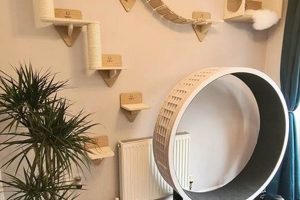The construction of sheltered habitats for felines, specifically designed for external environments and assembled by individuals, represents a practical approach to animal welfare. These structures offer protection from inclement weather, potential predators, and temperature extremes. Such constructs can range from simple shelters made from repurposed materials to elaborate, multi-room dwellings, depending on the builder’s resources and skill.
Providing outdoor feline shelters offers several benefits. It enhances the well-being of stray and feral cats by improving their chances of survival, particularly during harsh seasons. Furthermore, it can help control local feline populations by offering a designated area for feeding and observation, facilitating trap-neuter-release programs. The practice aligns with responsible community animal management, promoting a more humane approach to dealing with stray animals.
The following sections will explore various aspects of building suitable feline habitats. It will discuss material selection, design considerations, construction techniques, and strategies for attracting cats to the finished shelter. This information aims to equip readers with the knowledge necessary to create safe and functional shelters for felines in outdoor settings.
Practical Advice for Constructing Outdoor Feline Sanctuaries
Effective creation of durable and comfortable external shelters for felines necessitates careful planning and execution. The following guidance aims to assist in producing effective, safe, and enduring habitats.
Tip 1: Material Selection is Paramount: Opt for weather-resistant materials such as treated lumber, durable plastics, or repurposed items designed for external use. Untreated wood is susceptible to rot and insect infestation, rendering it unsuitable for long-term protection.
Tip 2: Insulation is Crucial: Incorporate insulation materials like rigid foam or straw to maintain a stable internal temperature. Avoid fiberglass insulation, as it can be harmful if ingested or inhaled by felines. Consider the local climate when selecting insulation.
Tip 3: Design for Weather Protection: Ensure the structure is elevated slightly off the ground to prevent water intrusion. A sloped roof will facilitate water runoff, preventing pooling and potential leaks. The entrance should be small and shielded from prevailing winds.
Tip 4: Prioritize Safety: Avoid using toxic paints, finishes, or adhesives in construction. Securely fasten all components to prevent collapse or disintegration. Regularly inspect the structure for hazards like sharp edges or protruding nails.
Tip 5: Camouflage and Location: Position the shelter in a discreet location, away from heavy foot traffic and potential disturbances. Camouflaging the structure with natural elements, such as foliage or paint that blends with the surroundings, can reduce the risk of vandalism or unwanted attention.
Tip 6: Maintenance is Essential: Implement a regular maintenance schedule to address any damage or deterioration. Clean the interior periodically to prevent the buildup of bacteria and parasites. Replace bedding and insulation as needed to maintain hygiene and thermal performance.
The application of these guidelines enhances the suitability and longevity of external feline shelters, contributing to the well-being of their occupants.
The subsequent sections will delve into specialized design modifications and considerations for unique environmental challenges.
1. Weatherproof Material Selection
Weatherproof material selection is a cornerstone of effective outdoor feline shelter construction. The materials employed directly impact the structure’s ability to withstand environmental stressors, thereby influencing the safety, comfort, and longevity of the refuge provided to felines. Careful consideration of material properties is therefore paramount.
- Moisture Resistance
Materials used in external feline shelters must exhibit high resistance to moisture penetration. Persistent exposure to rain, snow, and humidity can lead to material degradation, fostering mold growth and structural weakening. Examples of suitable materials include treated lumber, durable plastics, and roofing membranes. Failure to address moisture concerns can result in a shelter that becomes uninhabitable and potentially harmful to its occupants.
- Thermal Insulation Properties
The material’s ability to insulate against temperature extremes is critical for maintaining a stable internal environment. Materials with poor thermal properties will result in a shelter that is excessively hot in summer and excessively cold in winter, negating its protective function. Closed-cell foam insulation, straw bales, and specialized thermal barriers are effective options. The choice of insulation should be tailored to the specific climate conditions.
- Resistance to UV Degradation
Prolonged exposure to ultraviolet radiation from sunlight can cause many materials to degrade, becoming brittle and prone to cracking. This is particularly relevant for plastic and synthetic components. Selecting materials with inherent UV resistance or applying protective coatings can significantly extend the lifespan of the shelter. Neglecting this aspect can lead to premature failure of the structure and necessitate costly repairs.
- Durability and Structural Integrity
The chosen materials must possess sufficient structural integrity to withstand physical stresses, including wind loads, snow accumulation, and potential animal activity. Weak or flimsy materials can result in a shelter that is easily damaged or collapses, posing a safety risk to the felines. Employing robust construction techniques and selecting durable materials are crucial for ensuring the long-term stability of the structure.
In conclusion, weatherproof material selection is not merely an aesthetic consideration but a fundamental aspect of responsible external feline shelter construction. The careful selection of materials with appropriate moisture resistance, thermal insulation properties, UV resistance, and structural integrity is essential for creating a safe, comfortable, and durable refuge that will effectively protect felines from the elements.
2. Adequate Thermal Insulation
Adequate thermal insulation represents a critical design element in any externally situated feline shelter. Its presence dictates the structure’s ability to maintain a habitable internal temperature, irrespective of external climatic conditions. The efficacy of insulation directly correlates with the feline occupant’s health and survival, particularly during periods of extreme temperature.
- Temperature Regulation
Effective insulation mitigates rapid temperature fluctuations within the shelter. This stability prevents overheating during summer months and minimizes heat loss during winter, maintaining a more consistent and comfortable environment for the feline. For example, a shelter constructed without adequate insulation can experience temperature swings mirroring the external environment, potentially leading to heatstroke or hypothermia in the occupant. This is crucial in regions with significant diurnal temperature variations.
- Energy Conservation
While a feline shelter does not utilize powered heating or cooling systems, insulation reduces the passive heat loss from the animal’s body heat. This minimizes the energetic demands on the feline to maintain its core temperature, conserving vital energy reserves. Consider a feline expending significant energy to stay warm in an uninsulated shelter during winter. Conversely, an insulated shelter reduces this energy expenditure, allowing the feline to allocate resources toward other essential functions, such as immune response and hunting.
- Material Selection and Application
The choice and application of insulating materials directly impact the thermal performance of the shelter. Materials such as rigid foam insulation, straw bales, and specialized thermal blankets offer varying degrees of insulation, requiring careful selection based on the prevailing climate. Improper installation, such as gaps or insufficient thickness, can compromise the insulation’s effectiveness. Overlapping and sealing seams in insulation, or using a thicker layer, enhances thermal performance considerably.
- Microclimate Creation
An insulated shelter creates a microclimate distinctly different from the surrounding environment. This microclimate buffers the feline from the harshest elements, providing a refuge against wind, rain, and extreme temperatures. The microclimate effect enhances the shelter’s overall value as a protective haven. A well-insulated shelter can maintain an internal temperature significantly warmer than the external environment, even without an external heat source, thereby creating a life-saving refuge.
The integration of adequate thermal insulation within an externally located feline shelter is thus paramount to the structure’s function. It directly influences temperature regulation, energy conservation, material selection, and microclimate creation. These factors collectively ensure the survival and well-being of the feline occupant, thereby justifying the emphasis on robust insulation practices in construction.
3. Predator-Resistant Entry
In the context of crafting external shelters for felines, a predator-resistant entry transcends mere design preference; it is a fundamental safety feature. Such a design mitigates the risk of intrusion by potentially harmful animals, enhancing the overall security and utility of the shelter. The strategic implementation of a predator-resistant entry significantly contributes to the feline’s sense of safety and well-being.
- Reduced Opening Size
Decreasing the entry opening minimizes the size of animals capable of accessing the shelter. A smaller opening necessitates a potential predator contorting its body, hindering rapid entry and providing the feline with time to react or escape. For instance, an entry aperture measuring six inches in diameter may deter larger predators while still accommodating feline passage. The physical constraint of the opening serves as a primary defense mechanism.
- Tunnel or Offset Design
Implementing a tunnel or offsetting the entry point creates a visual and physical barrier. Predators are less likely to pursue prey into an enclosed space where they cannot directly observe the interior. A short tunnel extending inward from the opening complicates predator access, requiring a more deliberate entry and potentially deterring opportunistic attacks. This design element disrupts the direct line of sight, affording the feline a crucial advantage.
- Elevated Entry Point
Raising the entrance above ground level introduces a vertical challenge for potential predators. This design requires predators to exert greater effort to reach the entry, potentially deterring those less motivated or physically capable. For example, an entry elevated by one foot necessitates a predator to jump or climb, actions that reduce stealth and provide an early warning to the feline. Elevation adds a further layer of physical difficulty, dissuading casual intrusion.
- Durable Construction Materials
Employing robust materials in the entry construction resists forced entry attempts. Weak or easily damaged materials compromise the shelter’s security, rendering the predator-resistant design ineffective. Using treated lumber, reinforced plastic, or metal plating strengthens the entry against clawing, biting, or other forceful intrusions. Material durability is a key component in maintaining the long-term integrity of the predator-resistant feature.
The cumulative effect of these design elements contributes significantly to the overall safety and efficacy of the external feline shelter. A well-executed predator-resistant entry, incorporating reduced opening size, tunnel or offset design, elevated entry point, and durable construction materials, provides a tangible benefit to the feline occupant, minimizing the risk of predatory intrusion and enhancing its overall sense of security.
4. Elevated Base Structure
An elevated base structure constitutes a critical design element in the realm of self-assembled, external feline shelters. The primary function of elevating the structure is to mitigate direct contact with the ground, addressing several key environmental hazards that directly impact the shelter’s integrity and the well-being of its occupant. For example, direct contact with the ground facilitates moisture wicking, accelerating material degradation in wooden structures. It also exposes the shelter to ground-level pests, such as insects and rodents, which can compromise insulation and create unsanitary conditions. An elevated base, even a few inches off the ground, acts as a preventative measure against these threats, thus extending the shelter’s lifespan and enhancing its habitability.
The impact of an elevated base extends beyond mere protection from moisture and pests. It also provides a thermal barrier. By creating an air gap beneath the shelter, heat loss to the cold ground is reduced, contributing to a more stable internal temperature, particularly during colder months. This is of particular significance in regions experiencing sub-freezing temperatures, where ground frost can exacerbate heat loss. Consider the practical implications: a shelter placed directly on the ground will experience significantly greater conductive heat loss than one elevated by even a small margin, placing additional metabolic stress on the animal within. Furthermore, an elevated base can offer a degree of protection from shallow flooding or standing water during periods of heavy rainfall, safeguarding the interior from water damage and maintaining a dry and comfortable environment.
In conclusion, the inclusion of an elevated base structure is not merely an aesthetic choice but a practical necessity in the construction of external feline shelters. By preventing moisture wicking, deterring pests, providing a thermal barrier, and offering flood protection, an elevated base significantly contributes to the durability, hygiene, and thermal performance of the shelter. Neglecting this design element can result in a structure that is prone to premature decay, pest infestation, and inadequate temperature regulation, ultimately compromising the safety and well-being of the feline occupant. Therefore, in the context of self-assembled, outdoor feline shelters, an elevated base is an indispensable feature, aligning with the core objectives of providing a safe, durable, and comfortable refuge.
5. Strategic Location Placement
Strategic location placement is a determinant factor in the success of any self-constructed, external feline shelter. The location selected directly influences the shelter’s utilization, effectiveness in providing protection, and longevity. A poorly chosen site can render an otherwise well-constructed shelter ineffective or even detrimental to the intended occupant. For example, placing a shelter in an area exposed to prevailing winds or direct sunlight will negate the benefits of insulation and weatherproofing, increasing the feline’s risk of exposure to the elements. Conversely, a carefully selected location can maximize the shelter’s protective capabilities and encourage its use.
Considerations for strategic placement include protection from environmental elements, accessibility for the feline, proximity to food and water sources (if applicable), and concealment from potential threats, both human and animal. Shelters placed against existing structures, such as buildings or fences, benefit from added protection from wind and rain. Positioning the shelter near a cat’s established feeding area, while maintaining some distance for safety, can encourage its use. Concealment, achieved through placement behind shrubbery or in a sheltered alcove, reduces the likelihood of disturbance by humans or larger animals, creating a more secure environment. The cause-and-effect relationship is clear: thoughtful placement leads to increased shelter usage and improved feline welfare, while haphazard placement can have the opposite effect.
In conclusion, strategic location placement is an indispensable aspect of successful, self-assembled, outdoor feline shelters. It influences the shelter’s functionality, accessibility, and overall effectiveness in providing a safe and comfortable refuge. While material selection and construction techniques are important, they are secondary to the crucial decision of where to place the shelter. Therefore, careful consideration of the surrounding environment and feline behavioral patterns is essential to maximize the benefits of the shelter and ensure its long-term utility. The ultimate goal is to create a haven that the feline will readily utilize, thereby improving its chances of survival and well-being.
Frequently Asked Questions
The following addresses common inquiries regarding the design, construction, and maintenance of self-assembled feline shelters intended for outdoor use. The information aims to clarify best practices and address potential concerns.
Question 1: What are the most suitable materials for constructing a durable, weatherproof shelter?
Pressure-treated lumber, durable plastics, and repurposed materials designed for external use are generally recommended. Avoid untreated wood, which is susceptible to rot and insect infestation. Roofing materials should be waterproof and resistant to UV degradation.
Question 2: How can adequate insulation be incorporated into the shelter to protect against temperature extremes?
Rigid foam insulation, straw bales, or specialized thermal blankets provide effective insulation. Avoid fiberglass insulation due to potential respiratory irritation. Ensure the insulation is properly sealed to prevent moisture absorption and maintain thermal performance.
Question 3: What design features can minimize the risk of predator intrusion?
A small entry opening (approximately 6 inches in diameter), a tunnel or offset entry design, and an elevated entry point can deter predators. Reinforce the entry structure with durable materials resistant to clawing and biting.
Question 4: How high should the shelter be elevated above the ground, and what materials are suitable for the base?
Elevating the shelter 4-6 inches above ground level is generally sufficient. Use pressure-treated lumber, concrete blocks, or durable plastic supports for the base. Ensure the base is stable and level to prevent tipping or collapse.
Question 5: Where is the most advantageous location to place the shelter in an outdoor environment?
Select a location that provides protection from prevailing winds, direct sunlight, and heavy rainfall. Place the shelter against an existing structure or in a sheltered area with minimal foot traffic. Consider proximity to the feline’s established feeding area, if applicable.
Question 6: What maintenance procedures are necessary to ensure the shelter remains safe and functional?
Regularly inspect the shelter for damage, such as cracks, leaks, or loose components. Clean the interior periodically to prevent the buildup of bacteria and parasites. Replace bedding and insulation as needed to maintain hygiene and thermal performance.
Adhering to these guidelines enhances the safety, durability, and effectiveness of self-assembled, external feline shelters, contributing to the well-being of their occupants.
The subsequent section will address advanced design considerations and modifications for specific environmental challenges.
Conclusion
This exploration of the construction of external feline shelters has highlighted several critical aspects, including material selection, insulation techniques, predator protection, elevation, and strategic placement. Each element contributes to the overall efficacy and longevity of these shelters, serving as vital resources for the welfare of free-roaming felines. The principles outlined should be adhered to for effective construction.
The provision of adequate shelter represents a tangible intervention in mitigating the challenges faced by felines in outdoor environments. Continued application of these practices remains imperative in fostering more humane and sustainable interactions with animal populations. The responsible action of building and maintaining these houses should be the standard.







